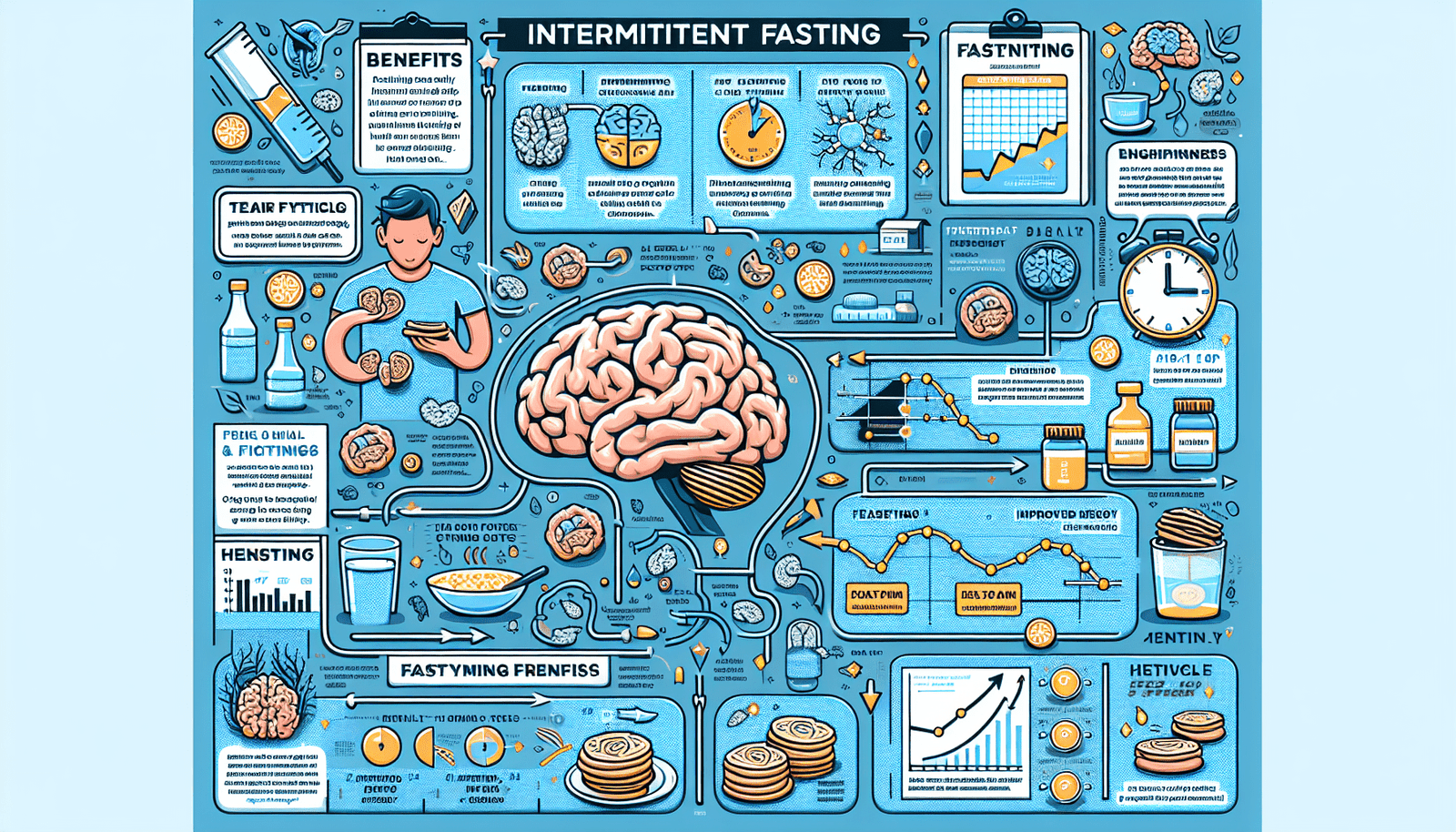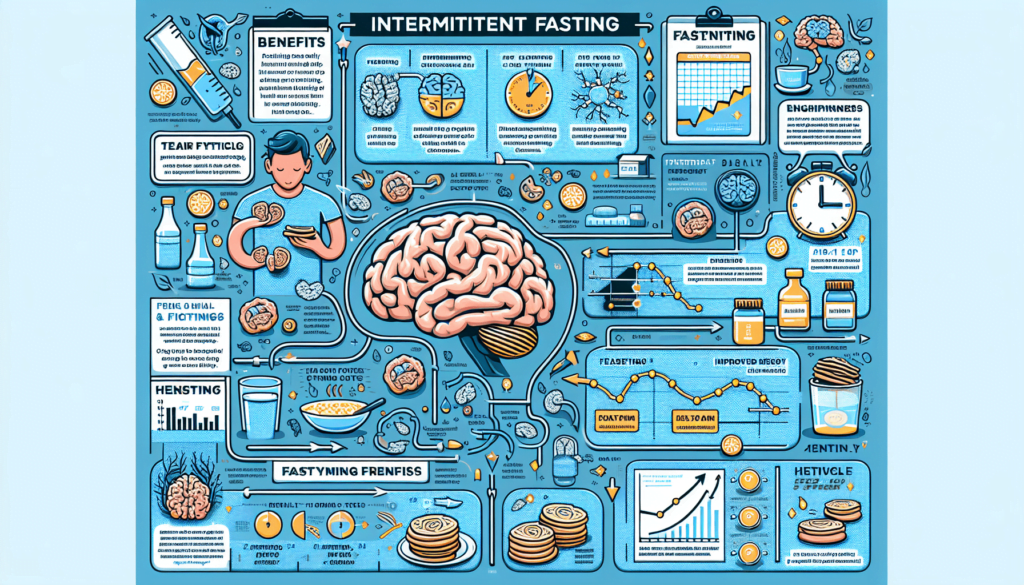If you’re looking to boost your cognitive function and overall brain health, intermittent fasting might be just the solution for you. This beginner’s guide will walk you through the basics of intermittent fasting, explaining what it is and how it can benefit your brain. By restricting your eating window and giving your body a break from constant digestion, intermittent fasting has been shown to improve cognitive function, enhance memory, and even protect against neurodegenerative diseases like Alzheimer’s. So, if you’re ready to improve your brainpower, let’s dive into the world of intermittent fasting.

What is Intermittent Fasting?
Intermittent fasting is a dietary pattern that involves alternating periods of fasting and eating. It is not a diet in the traditional sense, but rather a way of structuring your meals to optimize health and promote various benefits. The key idea behind intermittent fasting is to restrict the time window in which you consume calories, rather than restricting the types or amounts of food you eat.
Definition of intermittent fasting
Intermittent fasting typically involves fasting for a certain number of hours each day or week, and then eating within a defined time window. The most common approach is the 16/8 method, which involves fasting for 16 hours and eating within an 8-hour window. Other popular intermittent fasting protocols include the 5:2 method, where you eat normally for 5 days and restrict calories to 500-600 on 2 non-consecutive days, and alternate day fasting, where you fast every other day.
Different types of intermittent fasting
There are several variations of intermittent fasting that you can choose from, depending on your goals and lifestyle. Apart from the more common methods mentioned earlier, some people prefer a longer fasting period such as the 20/4 method, where you fast for 20 hours and eat within a 4-hour window. Another alternative is the Eat-Stop-Eat method, where you fast for 24 hours once or twice a week. It’s important to find a fasting schedule that suits your preferences and is sustainable for you.
How Intermittent Fasting Affects Cognitive Function
Intermittent fasting has been found to have various effects on cognitive function and brain health. Fasting can stimulate the production of certain proteins and molecules in the brain that promote the growth and survival of neurons. It has also been shown to enhance synaptic plasticity, which is the brain’s ability to adapt and form new connections. These effects can have positive implications for memory, learning, and overall cognitive performance.
Impact of fasting on brain health
When you fast, your body goes through metabolic changes that can have a profound impact on your brain health. One of the key mechanisms behind this is the increase in ketone production. Ketones are molecules that are produced from stored fat when your body is in a state of prolonged fasting or low carbohydrate intake. Ketones can provide an alternative fuel source for the brain, which can enhance cognitive function and protect against neurodegenerative diseases.
Scientific research and studies on cognitive benefits of intermittent fasting
Numerous studies have explored the effects of intermittent fasting on cognitive function, and the results have been promising. A review of animal and human studies published in the journal Cell Metabolism found that intermittent fasting can improve various aspects of brain health, including learning and memory, mood regulation, and neuroplasticity. Another study published in the journal Proceedings of the National Academy of Sciences demonstrated that intermittent fasting can enhance cognitive flexibility and improve cognitive performance in mice.
Choosing the Right Intermittent Fasting Protocol
There are several popular intermittent fasting protocols to choose from, and selecting the right one for you depends on various factors such as your lifestyle, goals, and personal preferences.
Overview of popular intermittent fasting protocols (16/8, 5:2, alternate day fasting)
The 16/8 method is one of the most popular and easiest methods to start with. It involves fasting for 16 hours and eating within an 8-hour window. For example, you might choose to skip breakfast and start eating at noon, and then finish your last meal by 8 PM. The 5:2 method involves eating normally for 5 days and then restricting calories to around 500-600 on 2 non-consecutive days. Alternate day fasting, as the name suggests, involves fasting every other day, with some variations allowing for a small number of calories on fasting days.
Factors to consider when selecting a protocol
When choosing an intermittent fasting protocol, it’s important to consider your daily schedule, eating habits, and individual goals. Some people may find it easier to skip breakfast and have a later eating window, while others may prefer to skip dinner. It’s also important to consider any underlying medical conditions and consult with a healthcare professional before starting any fasting regimen.

Precautions and Safety Measures
While intermittent fasting has been shown to have numerous health benefits, it may not be suitable for everyone. It’s important to approach it with caution and keep certain precautions in mind.
Consulting with a medical professional
Before starting any fasting regimen, it’s always a good idea to consult with a medical professional, especially if you have any underlying health conditions or are taking medications. They can provide personalized advice and guidance based on your individual needs and circumstances.
Potential risks and side effects of intermittent fasting
While intermittent fasting is generally considered safe for most people, it can cause some side effects such as hunger, fatigue, and irritability, especially during the initial stages of adaptation. It’s also important to ensure that you are still consuming enough calories and nutrients during your eating windows to support your overall health and well-being.
Preparing for Intermittent Fasting
Preparing for intermittent fasting involves assessing your current eating habits, making gradual transitions, and planning your meals accordingly.
Assessing your current eating habits
Take a close look at your current eating habits and identify any patterns or habits that may hinder your fasting journey. For example, if you are used to snacking late at night, you may need to adjust your eating window accordingly.
Gradual transition to fasting
If you’re new to intermittent fasting, it’s generally recommended to make a gradual transition instead of diving straight into longer fasting periods. Start by gradually increasing the duration of your fasting window each day or week until you reach your desired fasting protocol.
Meal preparation and planning
Planning your meals in advance can help ensure that you have nutritious and satisfying options available during your eating windows. Focus on consuming whole, nutrient-dense foods that provide a balance of macronutrients and micronutrients to support your overall health and well-being.
Tips for a Successful Intermittent Fasting Journey
To make the most of your intermittent fasting journey, here are some tips to keep in mind:
Staying hydrated
During fasting periods, it’s important to stay hydrated by drinking an adequate amount of water. You can also include other non-caloric beverages such as herbal tea or black coffee to help curb hunger.
Consuming nutrient-dense foods during eating windows
Make sure to prioritize nutrient-dense foods during your eating windows to support your overall health and well-being. Focus on lean proteins, whole grains, fruits, vegetables, and healthy fats.
Managing hunger and cravings
Hunger and cravings are common during fasting periods, especially in the beginning. To help manage these, you can include high-fiber foods, protein-rich foods, and healthy fats in your meals to promote satiety and keep you feeling full for longer.
Creating a consistent fasting schedule
Consistency is key when it comes to intermittent fasting. Try to establish a consistent fasting schedule that works for you and stick to it as much as possible. This can help your body adapt and optimize the benefits of fasting.
Intermittent Fasting and Mental Clarity
Intermittent fasting has been associated with enhanced mental clarity and focus.
Enhancement of focus and concentration
Many individuals who practice intermittent fasting report improved focus and concentration. This may be due to the cognitive benefits of fasting, such as increased production of ketones and improved neuroplasticity.
Effect of fasting on brain-derived neurotrophic factor (BDNF)
Fasting has been shown to stimulate the production of brain-derived neurotrophic factor (BDNF), a protein that plays a crucial role in the growth and survival of brain cells. Increased levels of BDNF have been linked to improved cognitive function and protection against neurodegenerative diseases.
Potential Benefits Beyond Cognitive Function
Intermittent fasting offers a range of potential benefits beyond improved cognitive function.
Weight loss and improved metabolic health
One of the primary reasons people choose intermittent fasting is for weight loss and improved metabolic health. Fasting can help reduce insulin levels, increase fat burning, and promote weight loss.
Reduced inflammation and cell regeneration
Intermittent fasting has been shown to reduce inflammation in the body, which is a key driver of many chronic diseases. It can also stimulate autophagy, a process that helps your body clear out damaged cells and regenerate new ones.
Exercise and Intermittent Fasting
Exercise can be incorporated into your intermittent fasting routine in a way that complements your goals and preferences.
Best practices for exercising during fasting hours
If you choose to exercise during your fasting period, it’s important to listen to your body and choose activities that are suitable for your energy levels. Light to moderate-intensity exercises such as walking, yoga, or low-impact aerobic workouts are generally well-tolerated during fasting periods.
Effect on muscle growth and performance
While exercising in a fasted state may help with fat burning, it may not be optimal for maximizing muscle growth and performance. If your goal is to build muscle or enhance athletic performance, consider consuming a balanced meal or snack containing protein and carbohydrates shortly before or after your workout.
Maintaining Intermittent Fasting in the Long-Term
To maintain intermittent fasting in the long-term, it’s important to build sustainable habits and make adjustments as needed.
Building sustainable habits
Start by incorporating intermittent fasting into your routine gradually and making it a sustainable lifestyle choice. Experiment with different fasting protocols and meal schedules to find what works best for you and your individual needs.
Adjusting the fasting protocol as needed
As you progress in your intermittent fasting journey, you may find that you need to adjust your fasting protocol. This could involve changing your fasting window, modifying the frequency of fasting days, or experimenting with different meal timings. Listen to your body and make adjustments as needed to ensure that you continue to reap the benefits of intermittent fasting.








